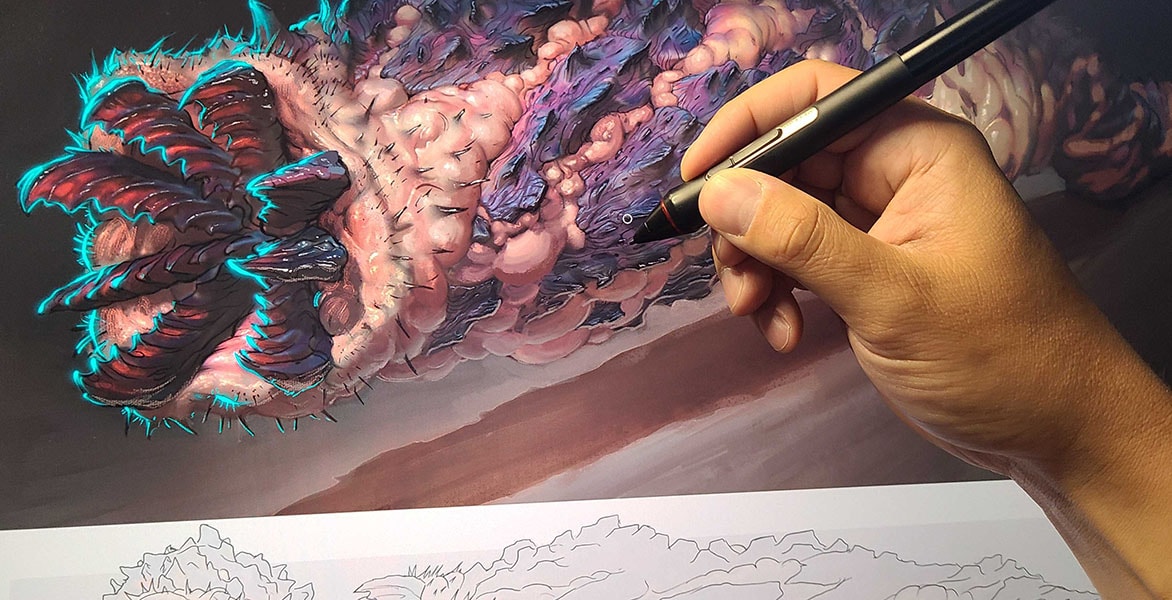& Construction

Integrated BIM tools, including Revit, AutoCAD, and Civil 3D
& Manufacturing

Professional CAD/CAM tools built on Inventor and AutoCAD
Andes giant glass frog by Saksham Kumar
3D digital painting involves painting or applying textures directly to a 3D model using 3D painting software and other digital tools. The process adds layers of depth and dimension to digital art.
Concept art by Brandon Reimchen. Image courtesy of CG Spectrum.
Digital 3D paintings are created using specialized software and tools. The process involves concept development and planning, followed by the creation of a virtual 3D model using modeling software. Texturing is applied to the models to provide realistic surfaces, and lighting is set up to create depth and highlights. The artist then uses 3D painting software to apply 3D paint and details to the models.
Post-processing effects can be added, and the artwork is rendered into a 2D image. Finishing touches are made, and the final artwork is saved in a suitable format. The specific software and tools used may vary, and the process may differ for still images or animated 3D paintings.
Image courtesy of Vitor Mar
Digital 3D painting offers the flexibility to easily undo or modify actions, allowing greater experimentation and exploration. The medium offers efficiency and speed through features like working in layers and automation tools.
Tools within 3D digital painting software let users create complex shapes, textures, and effects that may be challenging or time-consuming with traditional methods. The interactivity and immersive potential of 3D digital painting make it ideal for applications like virtual reality and video games.
Other advantages include digital distribution and integration with other digital workflows, allowing for easy sharing, wider reach, and smooth collaboration. While traditional painting has its unique qualities, 3D painting expands the artistic possibilities in the digital realm.
Image courtesy of Matt Miller
Digital 3D painting plays a crucial role in the film and gaming industries, enhancing the visual quality and realism of the final products.
In the film industry, 3D painting software is mainly used to create realistic, immersive visual effects (VFX). Artists use 3D modeling software to create detailed virtual environments, characters, and objects, which are then textured and painted using 3D digital painting tools for more realistic appearances. This process helps filmmakers bring fantastical worlds, creatures, and scenes to life and easily integrate them with live-action footage. Digital 3D painting is also used for intricate matte paintings, which serve as backgrounds or set extensions to enhance the film’s scope and ambiance.
3D digital painting is also a fundamental part of the game-development pipeline. Game artists use 3D modeling software to create characters, props, and environments. They then apply textures and digital paint to add details, surface materials, and visual flair. Digital 3D painting helps achieve stunning and realistic graphics, improving the overall visual quality of the game and developing interactive and dynamic environments that respond to the player’s actions for an immersive gaming experience.
Both industries rely on digital 3D painting software to create captivating and visually appealing content that transports audiences to new worlds and engages them in thrilling, immersive experiences. 3D modeling, texturing, and digital painting allow limitless artistic possibilities, making digital 3D painting an essential tool in modern filmmaking and gaming.
3D painting lets users add fine details and customized textures to 3D models, creating stunning and immersive experiences.
3D textures can enhance the realism and immersion of a finished piece; by adding intricate details like weathering and wear, artists can bring environments and characters to life.
Creating textures manually can be time-consuming. 3D digital painting tools optimize the process, allowing artists to produce more content in less time.
3D painting tools often conveniently integrate with popular 3D modeling software, carving out a workflow that makes it easier for users to create and collaborate.
Many modern 3D painting tools offer nondestructive editing features, letting artists make changes to textures without permanently altering the original data.
Digital 3D painting allows for a consistent art style throughout the project. Artists can reuse textures across multiple assets, allowing for a polished final product.
The digital nature of 3D painting allows for quick iteration and experimentation. Users can test different ideas, styles, and textures to find the best fit.
Scale your studio’s rendering and simulation capabilities, while equipping artists with powerful modeling and animation tools
CG SPECTRUM
Top game design, VFX, and animation school CG Spectrum recruits tomorrow’s top talent with Maya.
EIDOS MONTREAL
AAA game studios adopt USD to meet large-scale production needs.
WARNER BROS. GAMES | AVALANCHE
Warner Bros Games | Avalanche makes magic with Maya, MotionBuilder, and Flow Production Tracking (formerly ShotGrid).
Discover the software behind the cinematics and cyberware of Cyberpunk 2077.
Explore the pivotal role Autodesk software played in producing an award-winning animated short.
See how GhostVFX used Maya and Flow Production Tracking (formerly ShotGrid) to bring a giant main character to life.






